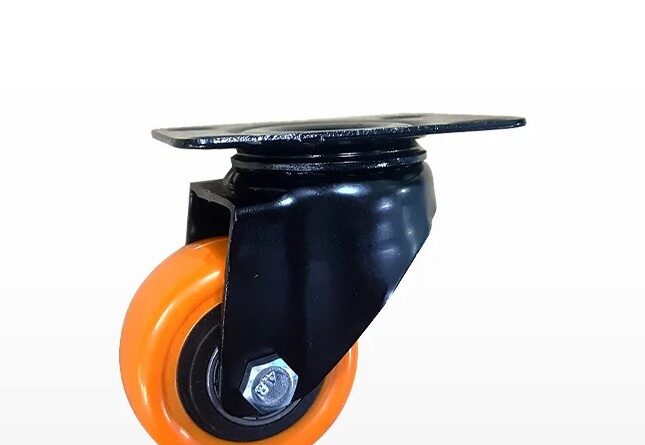How to Extend the Lifespan of Your Heavy-Duty Castor Wheels
Introduction
Heavy-duty castor wheels play a crucial role in industrial, commercial, and warehouse operations by ensuring smooth and efficient movement of heavy equipment. However, constant use, exposure to harsh environments, and improper maintenance can significantly reduce their lifespan.
Extending the durability of heavy-duty castor wheels not only reduces replacement costs but also enhances operational efficiency and safety. This guide explores essential maintenance practices, usage tips, and preventive measures to maximize the lifespan of your castor wheels.
1. Choose the Right Castor Wheels for the Application
Selecting the appropriate heavy-duty castor wheels for your specific use case is the first step toward ensuring longevity. Using wheels that are not suited for the load, environment, or surface can cause premature wear and failure.
Key Considerations When Choosing Castor Wheels:
✅ Load Capacity – Ensure the wheels can support the total weight of the equipment. Overloading leads to excessive strain and early breakdown.
✅ Wheel Material – Choose materials suited to your operating environment. For example:
- Polyurethane: Ideal for smooth floors and noise reduction.
- Rubber: Provides shock absorption but wears faster.
- Nylon or Metal: Best for rough surfaces and heavy loads.
✅ Floor Type – Hard floors require softer wheels for grip, while rough terrain needs larger, more durable wheels.
✅ Swivel vs. Fixed Castors – Use a combination of fixed and swivel castors for better maneuverability and stability.
Selecting the wrong heavy-duty castor wheels leads to frequent breakdowns and higher maintenance costs.
2. Regular Cleaning and Debris Removal
Accumulated dust, dirt, and debris can cause friction, increasing wear and tear on heavy-duty castor wheels. Regular cleaning prevents buildup that can hinder movement and damage wheel bearings.
Cleaning Tips:
🛠 Remove debris – Use a brush or compressed air to clear out dirt and particles from the wheel assembly.
🛠 Wipe surfaces – Use a damp cloth with mild detergent to clean off grease and grime.
🛠 Inspect for foreign objects – Small metal shards or stones can get lodged in the wheel, leading to uneven rolling and surface damage.
Cleaning wheels at least once a month, or more frequently in dusty environments, helps maintain smooth movement and extends their lifespan.
3. Lubrication for Smooth Performance
Proper lubrication of heavy-duty castor wheels ensures smooth rotation and reduces friction that causes wear. Without adequate lubrication, wheel bearings can become stiff and may even seize up, leading to operational downtime.
How to Lubricate Castor Wheels:
🔧 Use High-Quality Grease – Apply industrial-grade lubricant to wheel bearings and axles to reduce resistance.
🔧 Lubricate Moving Parts Regularly – Check the lubrication schedule based on the wheel’s frequency of use.
🔧 Avoid Over-Lubrication – Too much grease attracts dust and debris, leading to clogging.
Proper lubrication minimizes wear, prevents rust formation, and improves wheel performance.
4. Conduct Routine Inspections
Routine inspections help identify early signs of wear and prevent costly repairs or replacements. Regularly checking heavy-duty castor wheels ensures that minor issues don’t turn into major failures.
What to Inspect:
✔ Cracks or chips in the wheel material – This indicates potential failure points.
✔ Loose or worn-out bearings – Wobbly wheels can reduce stability and increase wear.
✔ Rust and corrosion – Moisture exposure can lead to rust, weakening the metal components.
✔ Bent or misaligned mounting plates – Misalignment affects movement and puts stress on the wheels.
Performing a monthly inspection helps detect problems early and extends the wheel’s service life.
5. Avoid Overloading the Wheels
Each set of heavy-duty castor wheels is designed to carry a specific weight limit. Exceeding this limit can lead to faster deterioration, cracking, and even wheel failure.
How to Prevent Overloading:
⚠ Check Manufacturer Load Ratings – Always follow the recommended weight capacity for the wheels.
⚠ Distribute Weight Evenly – Uneven loads cause excessive strain on certain wheels, leading to imbalance and premature wear.
⚠ Use Additional Wheels for Heavy Loads – If necessary, use extra wheels to share the weight load and reduce strain on each wheel.
Overloading can reduce the functional lifespan of your castor wheels by more than 50%.
6. Protect Wheels from Harsh Environments
Heavy-duty castor wheels often operate in extreme conditions such as wet areas, chemical exposure, or high temperatures. These conditions can accelerate wheel deterioration.
Protective Measures for Different Conditions:
🔥 Heat-Resistant Wheels – Use phenolic or high-temperature nylon wheels for high-heat environments.
💧 Corrosion-Resistant Coatings – Stainless steel or polyurethane-coated wheels resist rust in wet conditions.
🧪 Chemical-Resistant Wheels – Choose polyurethane or thermoplastic wheels for chemical-prone areas.
Matching the right wheel material to your working conditions prevents premature wear and extends lifespan.
7. Ensure Proper Installation and Alignment
Incorrect installation or misalignment can cause heavy-duty castor wheels to wear unevenly, reducing their effectiveness and lifespan.
Installation Best Practices:
🔩 Secure Fastening – Make sure all mounting bolts and brackets are tightened properly.
🔩 Check Alignment – Ensure wheels are aligned correctly to prevent excessive drag or uneven rolling.
🔩 Test After Installation – Roll the equipment to check for smooth movement and correct positioning.
Properly installed wheels reduce stress on the axles and bearings, ensuring smooth performance.
8. Store Equipment Properly When Not in Use
When equipment with heavy-duty castor wheels is left unused for long periods, improper storage can lead to wheel damage.
Storage Tips:
📌 Avoid resting heavy loads on stationary wheels for extended periods – This can cause flat spots.
📌 Store in a dry, temperature-controlled area – Prevents rust and material degradation.
📌 Raise equipment slightly off the ground – Reduces pressure on the wheels when not in use.
Proper storage practices help maintain wheel integrity and prevent unnecessary repairs.
Conclusion
Proper maintenance and usage practices can significantly extend the lifespan of heavy-duty castor wheels, reducing downtime and replacement costs. By choosing the right wheels, keeping them clean and lubricated, avoiding overloading, and inspecting them regularly, you can maximize their performance and durability.
Investing in high-quality heavy-duty castor wheels and following these best practices will ensure smooth operation, improved efficiency, and long-term reliability in industrial applications. 🚀


